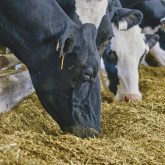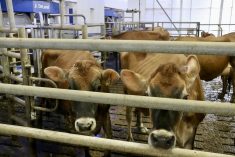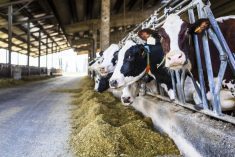Ontario’s dairy industry is in a period of unprecedented growth, with over 15 per cent more quota going to dairy farmers in less than two years.
There are almost certainly more quota increases to come, in order to increase milk production to displace significant volumes of butter now being imported.
“It’s an absolutely great time to be a dairy farmer,” Ralph Dietrich, chair of Dairy Farmers of Ontario (DFO), told the organization during its annual meeting held Wednesday and Thursday in Toronto. “We’re lucky to be in an industry like this at this point in time.”
Read Also

U.S. livestock: ‘Cattle on feed’ report supports prices
Chicago cattle futures rose as the USDA’s ‘Cattle on Feed’ report showed inventories two per cent down from a year…
That’s despite a perception of doom and gloom in supply-managed sectors over impending trade agreements such as the Canada-European Union Comprehensive Economic and Trade Agreement (CETA), which DFO general manager Peter Gould put in perspective at the meeting.
The erosion of tariff rate quotas (TRQs) under the CETA agreement will mean about 17,000 tonnes of EU cheese will be allowed into Canada over five years. That’s equivalent to about two per cent of national quota.
Supplemental import permits for butter for 2017 alone are expected to be about 12,000 tonnes — about three per cent of national quota. That butter should all eventually be covered by quota increases and produced in Canada.
The optimistic tone at the meeting comes from a storm of decision-making and renewed consumer confidence in dairy products over the past year, unlike any seen in the history of supply management — and Ontario was in the middle of it.
Ingredient strategy a game-changer
Specifically, the past year saw a strategy developed that reduced the price of milk used to make dairy ingredients in Ontario, in response to a growing mountain of non-fat solids (SNF) with few markets other than giveaway-grade animal feed.
At the same time, ironically, more highly-processed, inexpensive milk protein isolates were being imported.
Without a competitive Canadian supply of milk to use in ingredients, processors have had little impetus to invest in Canada’s aging dryer facilities, which process skim milk powder into a form that can be used to create milk protein isolates.
Dairy farmers had been working since at least 2006 to develop a national ingredients strategy, but that “just didn’t get done,” said Gould, who criticized the number of people involved in trying to negotiate the strategy — about 40 — as “too many.”
Ontario decided in late 2015 to go ahead with its own ingredients strategy, implemented in April 2016. Ontario’s board of directors was criticized from across the country, but stood firm.
By late spring, Manitoba also came on board with an ingredients strategy. The province was in a crisis with a lack of processing capacity. Quota was being reduced to farms and milk was being transported to British Columbia and Quebec.
SaskMilk also came on board, and together the groups forced national negotiations to come to a fairly quick agreement on a national ingredients strategy in July — something many people had said was impossible.
The national strategy has seen several delays in implementation since then, missing August and November deadlines. It is expected to be implemented next month, Gould said.
The ingredients strategy has resulted in a drop in the blend price — what farmers are paid for certain classes of milk, meaning less income to farmers — although that price improved in late 2016.
The strategy has also secured three significant investments by Canadian processors. Those include a Vitalus-Gay Lea joint venture to make milk ingredients and butter in Winnipeg; an investment by Parmalat in its Winchester, Ont. plant; and a $140 million investment by Gay Lea in processing in Ontario — including a dryer at its Teeswater, Ont. plant.
Both Gould and Dietrich called the ingredients strategy the most significant change for supply management since its creation.
A renewal of demand for dairy products has also helped, stemming from research that showed higher-fat products didn’t have the detrimental health effects previously identified in now-debunked studies.
DFO received support from the Ontario Farm Products Marketing Commission (which regulates marketing boards), provincial Agriculture Minister Jeff Leal and the Dairy Processors Association of Canada. Gould said.
The processors’ association, he added, has given its new CEO Jacques Lefebvre a new and helpful mandate.
Ontario producers, Gould said, were expected in other provinces to rebel against the ingredients strategy — but they did not and in fact were generally supportive of the DFO board.
“There has been a significant measure of conflict, which is not necessarily a bad thing when you end up with a result like the national ingredients strategy, which is an amazing outcome.
“What we’ve done is significant. We brought a commercial solution to an otherwise intransigent problem.”
The ingredients strategy could still face trade action from the U.S., where politicians, particularly in New York state, are already agitating against it.
Challenges with growth
The transition from a legacy industry to one with new investment and momentum will also create new challenges, said Gould, who retires from DFO this year after 36 years with the organization.
The largest such challenge will be how to move the dairy industry from a culture of scrambling to maintain scale, resulting in farm size stagnation, to one where there is the opportunity of growth, and indeed, under supply management, the obligation to supply the market.
That will mean significant choices for farmers, especially those in Ontario and Quebec, where older barns — mostly tie stalls, with limited ability for growth — will be challenged to fill new quota.
The sector does not want to have unfilled market demand, as farmers without the ability to fill new quota sit on 15 or 20 per cent unfilled quota that could be used by other farmers.
“The No. 1 challenge is how to keep up on the production side,” said Gould. “There are literally thousands of dairy farms facing big decisions about whether to expand, rebuild or not.”
That will require “serious dialogue,” Gould said, but questioned whether there’s a venue for such dialogue to take place.
— John Greig is a field editor for Glacier FarmMedia based at Ailsa Craig, Ont. Follow him at @jgreig on Twitter.
















